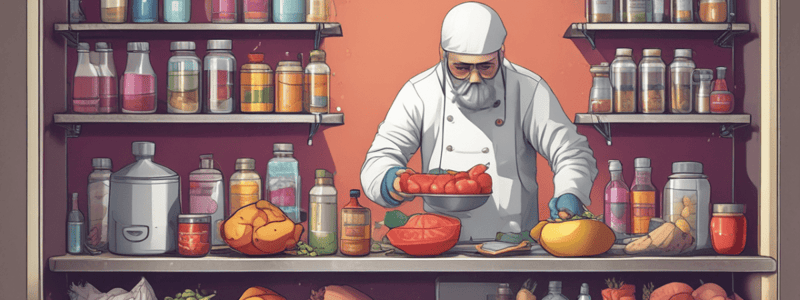Podcast
Questions and Answers
What are biological contaminants commonly responsible for in food?
What are biological contaminants commonly responsible for in food?
- Increasing food shelf life
- Improving nutritional value
- Enhancing flavor and aroma
- Making food unsafe for consumption (correct)
Which of the following is an example of a chemical contaminant?
Which of the following is an example of a chemical contaminant?
- Glass shards
- Salmonella
- Hair
- Pesticides (correct)
What is the first principle of HACCP?
What is the first principle of HACCP?
- Establish Monitoring Procedures
- Establish Record-Keeping
- Conduct a Hazard Analysis (correct)
- Determine Critical Control Points
Which action is associated with establishing corrective actions in HACCP?
Which action is associated with establishing corrective actions in HACCP?
How does HACCP enhance consumer confidence in food products?
How does HACCP enhance consumer confidence in food products?
What is a physical contaminant in food?
What is a physical contaminant in food?
Which principle involves maintaining records of procedures in HACCP?
Which principle involves maintaining records of procedures in HACCP?
What type of food contamination is primarily caused by cross-contamination?
What type of food contamination is primarily caused by cross-contamination?
What is the purpose of establishing critical limits in HACCP?
What is the purpose of establishing critical limits in HACCP?
Which of the following is NOT considered a source of food contamination?
Which of the following is NOT considered a source of food contamination?
Flashcards are hidden until you start studying
Study Notes
Food Contaminants
-
Definition: Substances that make food unsafe or unsuitable for consumption.
-
Types of Contaminants:
- Biological Contaminants: Bacteria, viruses, parasites, and fungi.
- Examples: Salmonella, E. coli, Listeria.
- Chemical Contaminants: Pesticides, food additives, cleaning agents.
- Examples: Heavy metals (lead, mercury), toxins (aflatoxins).
- Physical Contaminants: Foreign objects in food.
- Examples: Glass, metal shards, hair.
- Biological Contaminants: Bacteria, viruses, parasites, and fungi.
-
Sources of Contamination:
- Improper food handling and storage.
- Cross-contamination from raw to cooked foods.
- Contaminated water supply.
- Poor personal hygiene of food handlers.
HACCP Principles
- HACCP: Hazard Analysis and Critical Control Points, a systematic approach to food safety.
-
Conduct a Hazard Analysis:
- Identify potential hazards that could affect food safety.
- Evaluate the risks associated with each hazard.
-
Determine Critical Control Points (CCPs):
- Identify points in the food process where hazards can be controlled or eliminated.
-
Establish Critical Limits:
- Set maximum or minimum values (e.g., temperature, time) to ensure food safety at each CCP.
-
Establish Monitoring Procedures:
- Implement procedures to monitor CCPs to ensure they remain within critical limits.
-
Establish Corrective Actions:
- Define actions to be taken when monitoring indicates that a CCP is not within its critical limits.
-
Establish Verification Procedures:
- Create procedures to confirm that the HACCP system is working effectively.
-
Establish Record-Keeping and Documentation:
- Maintain detailed records of all procedures, monitoring, and corrective actions to ensure accountability and traceability.
Importance of HACCP
- Prevents foodborne illnesses.
- Ensures regulatory compliance.
- Enhances food quality and safety.
- Builds consumer confidence in food products.
Food Contaminants
- Contaminants are substances that render food unsafe or unsuitable for consumption.
- Biological Contaminants: Include bacteria, viruses, parasites, and fungi.
- Notable examples: Salmonella, E. coli, and Listeria are common pathogens associated with foodborne illnesses.
- Chemical Contaminants: Comprise pesticides, food additives, and cleaning agents.
- Heavy metals like lead and mercury, as well as toxins such as aflatoxins, pose significant health risks.
- Physical Contaminants: Foreign objects that can accidentally enter food.
- Examples include glass shards, metal pieces, and hair.
- Common sources of contamination include improper food handling, storage issues, cross-contamination between raw and cooked foods, contaminated water supplies, and poor personal hygiene of food handlers.
HACCP Principles
- HACCP (Hazard Analysis and Critical Control Points) is a structured approach to ensuring food safety by addressing and controlling potential hazards.
- Conduct a Hazard Analysis: Identify and assess hazards that may threaten food safety, focusing on risk evaluation.
- Determine Critical Control Points (CCPs): Pinpoint specific stages in food processing where hazards can be managed or eliminated.
- Establish Critical Limits: Define acceptable maximum and minimum values (e.g., temperature and time) to maintain safety standards at CCPs.
- Establish Monitoring Procedures: Create systems to continually observe CCPs, ensuring compliance with critical limits.
- Establish Corrective Actions: Define necessary steps if monitoring reveals that a CCP does not meet critical criteria.
- Establish Verification Procedures: Develop mechanisms to confirm that the HACCP system functions effectively and as intended.
- Establish Record-Keeping and Documentation: Keep comprehensive documentation of all procedures, monitoring results, and corrective actions for accountability and traceability.
Importance of HACCP
- Significantly reduces the occurrence of foodborne illnesses.
- Assures compliance with food safety regulations and standards.
- Improves the overall quality and safety of food products.
- Fosters increased consumer trust and confidence in food safety practices.
Studying That Suits You
Use AI to generate personalized quizzes and flashcards to suit your learning preferences.




